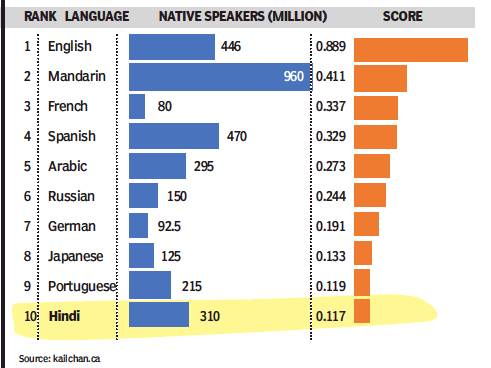Hindi language, the spread of
This is a collection of articles archived for the excellence of their content. |
Contents |
Global power
No. 10 in 2018
December 2, 2018: The Times of India

From: December 2, 2018: The Times of India
7,000 Estimated number of captive tigers — pets and zoo animals — in the US. It’s roughly double the world’s wild tiger population
English is world’s most powerful language, movies help Hindi finish at 10th place
How do we decide which is the world’s most powerful language? Should we go by the number of native speakers, or a language’s role in the global economy? Why not consider the geographical area over which a language is spoken, or its usefulness in diplomacy? But none of these parameters is enough by itself. So, Kai L Chan, a distinguished fellow at the French business school Insead, has developed a ‘Power Language Index’ that weighs each language’s influence over geography, economy, communication, knowledge & media, and diplomacy.
All things considered, English finishes first with a weighted score of 0.889 (out of 1), topping all five categories even though it has the third highest number of native speakers. Mandarin is a distant second. Hindi finishes 10th overall, but is second in the ‘knowledge & media’ category because of the large number of Hindi films made.
2019/ Abu Dhabi includes Hindi as 3rd official court language
February 10, 2019: The Times of India
In a landmark decision, Abu Dhabi has included Hindi as the third official language used in its courts, alongside Arabic and English, as part of a move designed to improve access to justice.
The Abu Dhabi Judicial Department on Saturday said it has extended the adoption of interactive forms of statement of claims filed before courts by including the Hindi language alongside Arabic and English in labour cases.
This is aimed at helping Hindi speakers to learn about litigation procedures, their rights and duties without a language barrier, in addition to facilitating registration procedures via unified forms available through the ADJD website, the judicial body said.
According to official figures, the UAE population is estimated to be around nine million of which 2/3rd are immigrants from foreign countries. The Indian community in the UAE, numbering 2.6 million, constitutes 30 per cent of the total population and is the largest expatriate community in the country.
Yousef Saeed Al Abri, undersecretary of the ADJD, said the adoption of multilingual interactive forms for claim sheets, grievances and requests, aims to promote judicial services in line with the plan Tomorrow 2021, and increase the transparency of litigation procedures.
"This is in addition to facilitating registration procedures to the public through simplified and easy forms and raising litigants' legal awareness via interactive forms of the statements of claims, to ensure access to the legal materials related to the subject of the dispute," Al Abri was quoted as saying by the Khaleej Times.
He indicated that the extension of the adoption of interactive forms in several languages comes under the directives of Sheikh Mansour bin Zayed Al Nahyan, Deputy Prime Minister and Minister of Presidential Affairs and ADJD Chairman.
Al Abri explained that the adoption of new languages comes as part of the bilingual litigation system, the first phase of which was launched in November 2018, through the adoption of procedures requiring the plaintiffs to translate the case documents in civil and commercial lawsuits into English, if the defendant is a foreigner.
"The foreign investor receives the case files translated, thus contributing to the provision of a global judicial service that meets the requirements of residents in the Emirate of Abu Dhabi," he added.
Tamil Nadu
2001-11, increase in speakers: South: 13%; TN: 50%; decline among Kannadigas
Tamil Nadu, which has long opposed the “imposition” of Hindi in the state, saw a rise of 50% Hindi speaker among Tamilians between 2001 and 2011, according to the latest census data. Overall, the percentage of Hindispeaking south Indians, however, rose by only 13% during the same period, and even declined among Kannadigas.
The anti-Hindi agitation of the 1960s led to several generations of Tamilians not learning the language. Things have changed with large scale migration of people from India’s north, north-east and northwest as blue collar and white collar workers.
“The absolute number of Tamilians speaking Hindi might be small. But given the current preference for CBSE and ICSE schools, more students could be opting for Hindi as second and third language. Also those looking for jobs outside Tamil Nadu may be learning Hindi,” said international population expert P Arokiasamy.
“There are several reasons for Tamilians learning Hindi. Migration is one, but TV programmes also influence Tamil people. The shift started when the Ramayana and the Mahabharata were telecast,” said sociologist G S Karanth.
All Tamilians speaking Hindi are not conversant with the language; many mix a bit of Tamil, English and Hindi and are able to convey what they want to say. “An autorickshaw driver may not be a Hindi pundit but if he can convey to his passenger in broken Hindi the charge for the ride, the route etc., the work is done. Thus learning Hindi also means increasing a person’s income in changed circumstances,” said Karanth. “Many company bosses are from the north and they only speak Hindi. Unless you learn Hindi, it will be difficult to work under them,” he said.
See also
Central Board of Secondary Education (CBSE)
Hindi language, the spread of